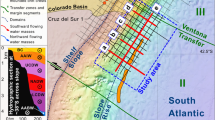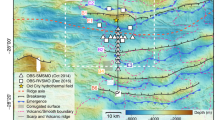Abstract
The elastic thickness of oceanic lithosphere, based on flexure studies in the region of surface loads, is two to three times smaller than its seismic thickness1. Thus, as a load ages, the thickness of the mechanically supportive part of the lithosphere must decrease from its short-term (seismic?) thickness to its long-term mechanical thickness. Extrapolation of data from experimental rock mechanics suggests that thinning occurs by brittle failure in the uppermost part of the lithosphere and thermally activated creep in its lower part2. Modelling shows that for load ages less than about 1 Myr, flexural moats change shape and the peripheral bulges migrate in towards the load3. These transient changes in flexure are best manifest, we believe, in the stratigraphical sequences that infill flexural moats. The largest thicknesses of sediments occur in moats flanking orogenic belts4,5. However, the stratigraphical record in these basins is complicated by the effects of compaction, sub-aerial erosion and sea-level changes, and by the fact that the loading history extends over very long periods of time. Here we describe a multichannel seismic reflection profile across a flexural moat flanking the volcanic load of Oahu in the Hawaiian Islands. The advantages of Oahu are that it is located in the interior of a plate, the load is 2.7 Myr old and formed within 1 Myr6, and the flexural moat was not significantly affected by sea-level changes and erosion. We show that the observed stratigraphical patterns cannot be explained by changes in material influx, load distribution, and rapid relaxation of the lithosphere to its long-term mechanical thickness. Rather, the observed patterns suggest a prolonged relaxation (>1 Myr) due to either local or regional re-heating of the lithosphere. This re-heating has important implications for the relationship between elastic thickness and age of the lithosphere at the time of loadings.
This is a preview of subscription content, access via your institution
Access options
Subscribe to this journal
Receive 51 print issues and online access
$199.00 per year
only $3.90 per issue
Buy this article
- Purchase on Springer Link
- Instant access to full article PDF
Prices may be subject to local taxes which are calculated during checkout
Similar content being viewed by others
References
Watts, A. B., Bodine, J. H. & Steckler, M. S. J. geophys. Res. 85, 6369–6376 (1980).
Goetze, C. & Evans, B. Geophys. J. R. astr. Soc. 59, 463–478 (1979).
Bodine, J. H., Steckler, M. S. & Watts, A. B. J. geophys. Res. 86, 3695–3707 (1981).
Jordan, T. E. Am. Ass. Petrol. geol. Bull. 65, 2506–2520 (1981).
Quinlan, G. M. & Beaumont, C. Can. Earth Sci. 21, 973–996 (1984).
Sen, G. Earth planet Sci. Lett. 62, 215–228 (1983).
Brocher, T. M. & ten Brink, U. S. J. geophys. Res (submitted).
Ewing, J. I., Ewing, M. & Aitken, T. Am. geophys. Un. Geophys. Mon. 12, 147–173 (1968).
Watts, A. B., ten Brink, U. S., Buhl, P. & Brocher, T. M. Nature 315, 105–111 (1985).
Mitchum, R. M. Jr, Vail, P. R. & Thompson, S. III Am. Ass. Petrol. geol. Mem. 26, 53–81 (1977).
Moore, J. G. Bull. Volcanol. 34, 562–576 (1970).
Gregory, A. E. & Kroenke, L. W. Am. Ass. Petrol. geol. Bull. 66, 843–859 (1982).
Detrick, R. S. & Crough, S. T. J. geophys. Res. 83, 1236–1244 (1978).
Watts, A. B. J. geophys. Res. 83, 5989–6004 (1978).
Courtney, R. C. & Beaumont, C. Nature 305, 201–204 (1983).
Author information
Authors and Affiliations
Rights and permissions
About this article
Cite this article
ten Brink, U., Watts, A. Seismic stratigraphy of the flexural moat flanking the Hawaiian Islands. Nature 317, 421–424 (1985). https://doi.org/10.1038/317421a0
Received:
Accepted:
Issue Date:
DOI: https://doi.org/10.1038/317421a0
This article is cited by
-
A geomorphological reconnaissance of the submarine part of the East Rift Zone of Kilauea Volcano, Hawaii
Bulletin of Volcanology (1989)
Comments
By submitting a comment you agree to abide by our Terms and Community Guidelines. If you find something abusive or that does not comply with our terms or guidelines please flag it as inappropriate.



